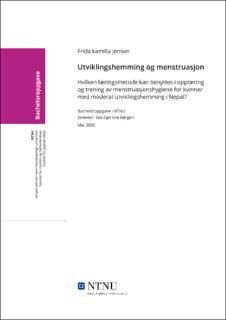| dc.contributor.advisor | Tale Gjertine Bjørgen | |
| dc.contributor.author | Jensen, Frida Kamilla | |
| dc.date.accessioned | 2020-07-14T16:05:33Z | |
| dc.date.available | 2020-07-14T16:05:33Z | |
| dc.date.issued | 2020 | |
| dc.identifier.uri | https://hdl.handle.net/11250/2664161 | |
| dc.description.abstract | Nøkkelord: menstruasjonshygiene, læringsmetoder, moderat utviklingshemming.
Bakgrunn: Menstruasjonshygiene er noe som inngår i læring av ADL (activities of daily living) ferdigheter. I land som Nepal, der utviklingshemming og menstruasjon er et tabu tema, er dette en utfordring. De får ikke samme informasjon og opplæring som normalbefolkningen. Hensikt: Hensikten med denne bacheloroppgaven er å belyse ulike læringsmetoder som kan benyttes for å lære menstruasjonshygiene, for personer med moderat utviklingshemming. Metode: Metoden som er benyttet i denne oppgaven er litteraturstudie. Resultat: Ut ifra funnene fra de inkluderte forskningene, ble det identifisert tre ulike læringsmetoder som kan benyttes: dukke, visuelle/sosiale fortellinger og simulering på seg selv. Konklusjon: Det er tre ulike metoder som kan benyttes når kvinner med utviklingshemming skal lære seg menstruasjonshygiene. Det kan være metoder man bruker for seg selv, eller kombinerer med andre. I tillegg til at metodene bidrar til at kvinnene lærer seg disse ferdighetene raskt, vil de også få en forståelse rundt situasjonene og temaet. | |
| dc.description.abstract | Keywords: Menstrual hygiene, learning methods, moderate intellectual disability
Background: Menstrual hygiene is a part of learning ADL (activities of daily living) skills. In countries like Nepal, where intellectual disability and menstruation are a taboo topic, this is a challenge. They do not receive the same information and training as the rest of the population in the country, which means they are not prepared when they experience their first period. Purpose: The purpose of this bachelor is to see different learning methods that can be used to teach menstrual hygiene, for people with moderate intellectual disability. Method: The method used in this bachelor is literature study Result: Based on the findings from the included research, three different learning methods were identified and can be used: a doll, visual/social stories and simulation on themselves. Conclusion: There are three different methods that can be used to teach menstrual hygiene to women with intellectual disability. Some of the methods can be used alone or combine with others. The methods are helping the women to learn the skills quickly and they will also gain an understanding of the situation. | |
| dc.publisher | NTNU | |
| dc.title | Utviklingshemming og menstruasjon | |
| dc.type | Bachelor thesis | |
